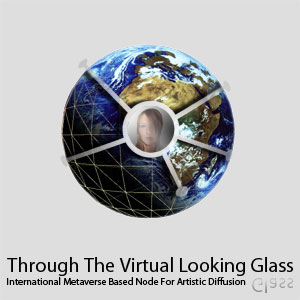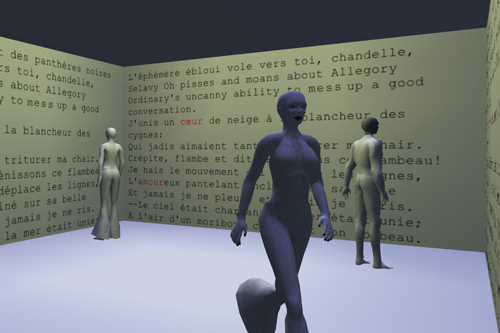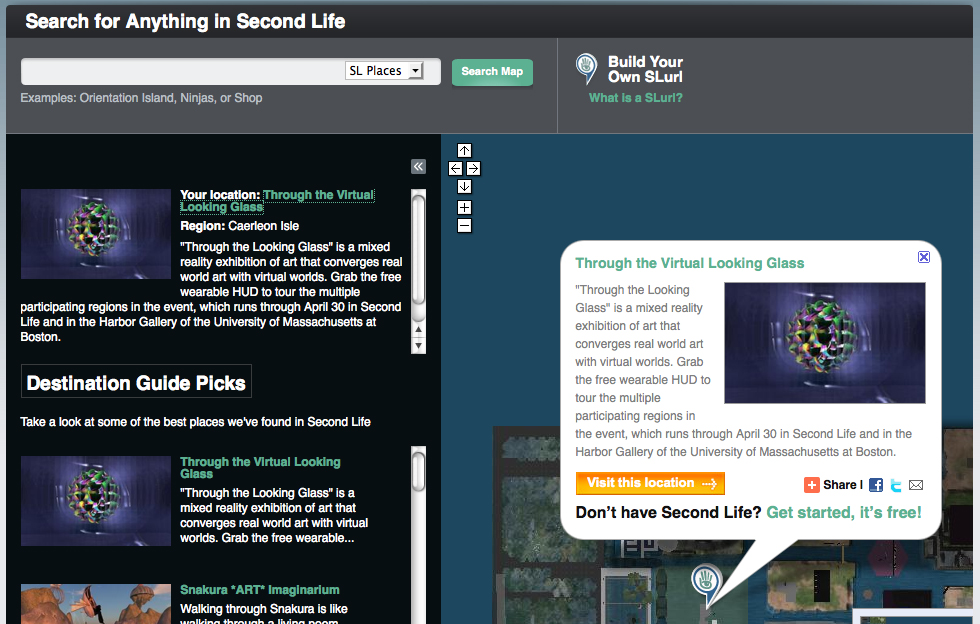Art production in virtual 3D worlds usually doesn’t happen in a vacuum. As a contemporary practice, virtual art can create social capital that provides opportunities for individual and collective action, generated by networks of relationships, reciprocity, and new social customs. Today’s entry and my subsequent posts feature individual artists and networks who are creating art inspired by or within perceptually immersive 3D spaces, from local groups and meetups to larger, international collectives that cross geographical, social, and cultural boundaries.
“Over the course of the last generation or two, a variety of technological, economic and social changes have rendered obsolete the stuff of American social capital.” — Robert Putnam, Bowling Alone
Rather than disappearing, social capital in the arts is undergoing fundamental shifts regarding participation as an aesthetic in emerging, new media forms on a constantly advancing Web platform. Art production in virtual 3D worlds bring digitally mediated art within a frame of contemporary, conceptual work. Artists are actively involved in this new media context, which is characterized by lower barriers of entry to artistic expression, production, and engagement. They receive support for creating their work, from monetary and virtual land grants to informal mentoring, wherein technical knowledge is passed along to novices. They are engaging in an online, participatory culture in which individual contributions matter, and artists in distant places feel some degree of connection to one another.
My series of posts present emerging, innovative practices in contemporary art, specifically through Web 2.0, a conceptual, web-based platform upon which new environments are being built to create art as a form of immersion and online social media. This includes accessible technological tools that allow artists to create and exchange content and engage in peer-to-peer discourse. Web 2.0 has come to play an integral part in the expansion of new art forms because it increasingly enables artists to work collaboratively; generate and disseminate information, ideas, and creative works; and connect with people who share similar goals and interests. This is Robert Putnam’s Bowling Alone vs. virtual art as a participatory culture and social capital. In virtual 3D worlds like Second Life, the social network is a primary factor of art production.
[youtube:https://www.youtube.com/watch?v=6olzn_rMaX4]
Through the Virtual Looking Glass, a mixed reality exhibition of art that converges real world art with virtual worlds, is happening this month, as a result of an international collaboration between the Virtual Arts Initiative, Pirats Art Nework, Cybernetic Art Research Project (CARP), and the University of Western Australia as the UWA Cultural Precinct.
The Caerleon sims are part of the Virtual Art Initiative, founded in Second Life by Dr. Gary Zabel (Georg Janick in SL) in 2008. The project has grown to include several sims (short for simulations) in Second Life and on Reaction Grid, another virtual 3D world. The Caerleon sims are home to over 30 resident artists and feature a wide range of exhibitions, collaborative projects, classes, and experimental virtual art spaces. I became aware of the Caerleon sims a little over a year ago, when I was invited to check out The Lost Wages of Sin, an “environmental assemblage installation” in Second Life by Pixel Sideways. The installation included a Betty Page peep show, among several wonderfully kitschy 1950s-themed posters, galleries, 3D objects and video displays.
In February 2010, I was invited to join their online collaboration site to discuss preparations for international exhibitions of virtual art in April and May. Artists and curators across the globe met online to express their interest in organizing local and regional art events in their countries and, where possible, streamed related media content into Second Life. The online collaboration culminated in Through the Virtual Looking Glass. Visitors are encouraged to tour the multiple participating regions in the event, which runs through April 30 in Second Life and at the Harbor Gallery of the University of Massachusetts at Boston. I will write more about Dr. Zabel and this collaborative virtual art exhibition in later posts.

https://www.virtual-looking-glass.org
Some common questions frequently come up regarding virtual art in Second Life.
How do I see it?
Well first, you must join Second Life in much the same way you would join Facebook or Twitter. Second Life has a vast network of residents who have real lives and log in to experience a virtual 3D world as avatars, with cool-sounding user names like Papillon Darkstone or Cyberstar Solo (my alternate SL user names). Many residents spend a lot of time and a fair amount of Linden cash (SL currency) to modify their avatar’s appearance, which can be done anytime, as many times as they choose.
After signing up, you can download the Second Life viewer for free. Anyone with access to high-speed Internet and an up-to-date computer can do this. The viewer requires your username and password to enter the virtual 3D world. Even if you don’t have what is required to download the SL viewer to your computer, you can still experience some aspects of the work through machinima.
[youtube:https://www.youtube.com/watch?v=rvza0yhK7Wc]
I wrote about machinima in my post for the Art 2.1 column entitled Performative Interventions. SL artist ColeMarie Soleil stated,
My intent is to document the art I find that has hidden stories inside of them. These videos bring them to life for a watcher who might not understand Second Life. Long after the builds are gone, the videos become like a trip back in time for friends and the artists who created them. It is a way to hold onto them as more than just memories or places we experienced.
Often, machinima serves as documentation of art created online. This happens in virtual 3D space that is distinctly different than becoming immersed, as a 3D avatar that freely moves within a world that transcends physical constraints and traditional concepts of time and space. Mixed Reality exhibitions often explore a variety of forms, including two-, three-, and four-dimensional aspects of art. Visitors are encouraged to bring both their material and virtual selves to the work.
What do I do when I log in?
Explore on your own, join a SL community, or visit one of hundreds of art-related destinations where users meet to network, communicate, and collaborate in-world. To promote events, SL residents create and publish map links called SLurls that teleport registered users (as 3D avatars) to their location on the virtual world grid. For example: secondlife://Caerleon%20Isle/215/71/25 is the SLurl for Through the Looking Glass.
Art exhibitions in Second Life often imitate real-life ones, with some key differences. Artists can permit visitors to fly or teleport around or view content from other distant locations. Openings can be exciting immersive 3D experiences that offer opportunities for users/residents across the globe to interact. Communication is not restricted or limited to text-based chats. SL viewers present streaming video, audio, and shared media, a new feature that lets users put Internet content on any prim (3D object) surface, with Web browser-like controls.
I am reminded of the Structures segment from Art:21 Season 5, featuring artists that “create systems, shift contexts, and engage with perception, utilizing unconventional devices such as exhibitions within exhibitions and dramatic shifts in scale between microcosm and macrocosm.” Virtual art in real life and virtual 3D worlds explores the parallel between visceral and mechanical systems. When writing about this work, I am often thinking about new structures and systems for production. I will write more about this in future posts.
[youtube:https://www.youtube.com/watch?v=gHlga9zXikA]
Pirats Art Network, founded by Merlina Rokocoko and Newbab Zsigmond, is dedicated to promoting art and creation. Newbab writes,
Its name refers to the 18th century’s Piracy in the sense of a free society, and sets the question of promoting Art in a little bit provocative way. Pirats doesn’t encourage hacking, but tries to promote Artists thanks to new technologies. Today, Pirats mostly uses Second Life, a fantastic metaverse, live on the net.
Yesterday, virtual worlds were associated with games. They mean a lot more today and their exponential development is the evidence that they provide answers to social needs, people looking for new space for personal expression.
I featured CARP in my Art 2.1 blog post Performative Interventions. Perhaps there are other similar networks out there in cyberspace that I have yet to encounter. It is my goal with these posts to explore virtual art as participatory culture within new, emerging technological (and aesthetic) forms, to help bridge worlds and social capital in art. Without such bridges, online social networks can become isolated from the rest of the art world and, most importantly, from other groups with which bridging must occur in order to increase social capital for the advancement of art in the 21st century.







Pingback: Brooklyn is Watching » Blog Archive » art:21- Bridging worlds
Pingback: Immersive & Interactive: Virtual 3D Art Revisited | Art21 Blog
Pingback: Call + Response: Collaborative Art in Virtual 3D Worlds | Art21 Blog
Pingback: Beyond Boundaries: Art Exhibition & Virtual 3D Worlds | Art21 Blog
Pingback: Art21 2009 to the Present « SL Art HUD Blog Thingie:
Pingback: Art 3.0: Bringing Art & Culture to the Masses | SL Art HUD Blog Thingie: